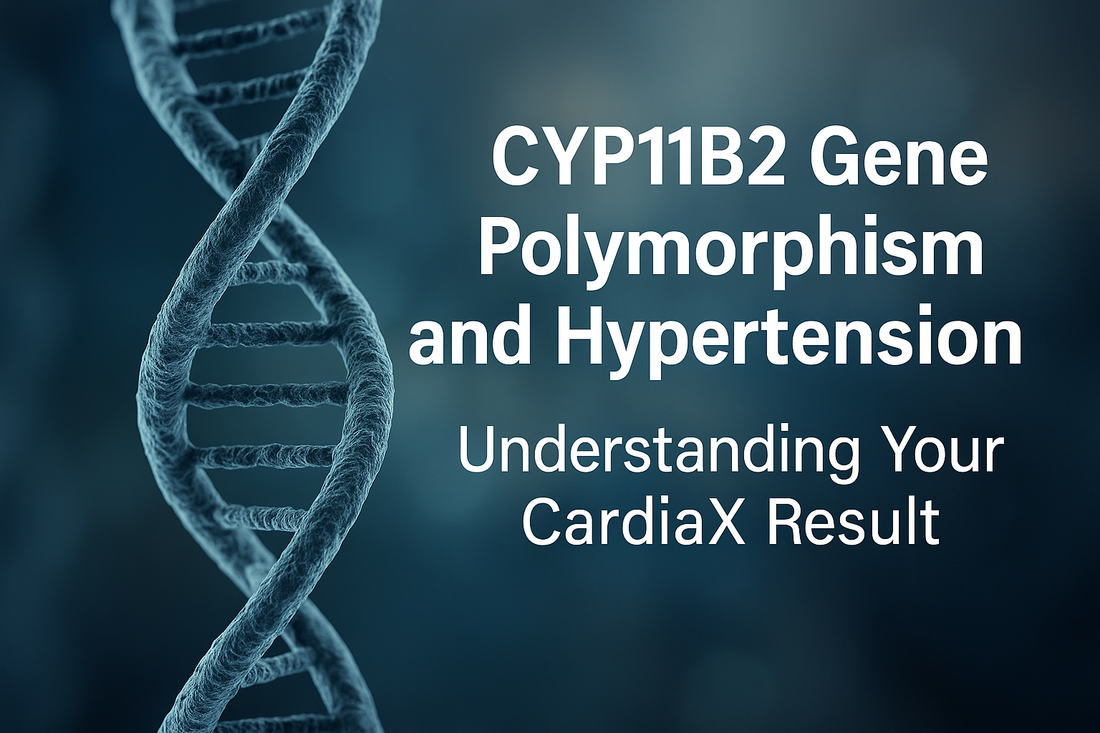CYP11B2: The Aldosterone Synthase Variant That Raises Hypertension and Cardiovascular Disease Risk
Introduction
The CYP11B2 gene, located on chromosome 8q24, encodes aldosterone synthase, the enzyme that converts corticosterone to aldosterone in the adrenal zona glomerulosa. Aldosterone regulates sodium and potassium balance, vascular tone, and blood pressure.
One of the most studied polymorphisms in CYP11B2 is the −344C/T variant (rs1799998) in the gene’s promoter region. This SNP influences transcriptional activity, alters aldosterone production, and has been consistently associated with hypertension, left ventricular hypertrophy (LVH), myocardial infarction, and stroke risk.
If your CardiaX test flagged CYP11B2, here’s why it matters, what factors increase its impact, and how you can take control of your cardiovascular health.
Understanding CYP11B2 and the −344C/T Variant
-
Normal function: CYP11B2 encodes aldosterone synthase, the rate-limiting enzyme for aldosterone biosynthesis.
-
Variant details: The −344C/T SNP sits in a promoter binding site for steroidogenic transcription factors. The T allele increases binding affinity and is associated with higher aldosterone synthase expression.
-
Clinical impact: Carriers of the T allele often exhibit:
-
Higher circulating aldosterone
-
Greater salt sensitivity
-
Increased risk of hypertension
-
Left ventricular hypertrophy (LVH)
-
Higher incidence of coronary artery disease and stroke
-
Mechanisms Linking CYP11B2 Variants to Cardiovascular Risk
-
Excess Aldosterone
-
Increases renal sodium reabsorption, expanding blood volume and raising blood pressure.
-
Promotes potassium wasting, which can destabilize cardiac electrophysiology.
-
-
Endothelial Dysfunction
-
Aldosterone enhances oxidative stress and reduces nitric oxide availability.
-
Stimulates inflammation in the vascular wall.
-
-
Cardiac Remodeling
-
Excess aldosterone contributes to fibrosis, hypertrophy, and stiffening of the left ventricle.
-
-
Vascular Stiffness and Atherosclerosis
-
Promotes collagen deposition in arterial walls, raising vascular resistance and pulse pressure.
-
What Increases the Risk from CYP11B2 Variants?
Even with genetic predisposition, environmental and metabolic factors amplify risk:
-
High-salt diets → exacerbate sodium retention.
-
Obesity and insulin resistance → synergize with aldosterone to stiffen arteries.
-
Low potassium intake → worsens aldosterone’s effects.
-
Chronic stress → stimulates the renin–angiotensin–aldosterone system (RAAS).
-
Poor sleep (especially sleep apnea) → raises nocturnal aldosterone and BP.
-
Sedentary lifestyle → lowers vascular compliance.
How to Mitigate CYP11B2 Risk
1. Lifestyle Strategies
-
Sodium restriction: Aim for ≤2,000 mg/day, especially in salt-sensitive individuals.
-
Potassium-rich diet: Emphasize leafy greens, avocados, beans, and bananas.
-
Mediterranean diet: Improves vascular function and lowers BP.
-
Exercise: 150–300 minutes/week of aerobic + resistance training reduces arterial stiffness.
-
Weight optimization: Even 5–10% weight loss reduces BP significantly.
-
Sleep hygiene: Screen for and treat sleep apnea.
2. Nutraceuticals
-
Magnesium glycinate: Improves vascular tone, insulin sensitivity, and BP regulation.
-
Omega-3 fatty acids — Omega 1300: Reduce vascular inflammation and arterial stiffness.
-
Coenzyme Q10 Omega — CoQ10 Omega: Supports endothelial health and lowers systolic BP in hypertensive patients.
-
Curcumin Complex — Curcumin Complex: Lowers oxidative stress and vascular inflammation.
-
Potassium citrate supplements (if not contraindicated): Corrects low-K states, improving aldosterone balance.
3. Peptide Therapies (Physician-Supervised)
-
BPC-157: Improves endothelial healing and reduces oxidative injury.
-
KPV: Reduces systemic inflammation, supporting vascular health.
-
MOTS-c: Improves metabolic flexibility, addressing obesity-driven hypertension.
4. Medications
For some CYP11B2 carriers, lifestyle alone is not enough.
-
Mineralocorticoid receptor antagonists (MRAs): Spironolactone, eplerenone — directly counter excess aldosterone, particularly effective in resistant hypertension.
-
ACE inhibitors/ARBs: Lower RAAS activity, reduce BP, and protect against cardiac remodeling.
-
Thiazide diuretics: Helpful in salt-sensitive hypertension.
-
Calcium channel blockers: Useful for additional BP control.
Case Example
A 52-year-old man with obesity, sleep apnea, and a CYP11B2 T allele presents with uncontrolled hypertension despite two medications.
Plan:
-
Nutrition: Mediterranean diet, sodium <2 g/day, potassium-rich foods.
-
Exercise: 200 minutes/week aerobic, resistance twice weekly.
-
Supplements: Omega 1300, magnesium glycinate, CoQ10 Omega.
-
Medications: Added spironolactone, continued ARB, tapered thiazide.
-
Peptide: KPV trial for inflammation reduction.
Result: BP dropped from 158/96 to 126/78 within four months; LVH regression on echocardiogram at one year.
The Bottom Line
The CYP11B2 −344C/T polymorphism influences aldosterone production, driving salt-sensitive hypertension, cardiac remodeling, and cardiovascular events. With CardiaX, identifying this risk allows clinicians to intervene earlier and more effectively.
Lifestyle, nutraceuticals, peptides, and targeted medications—especially mineralocorticoid receptor antagonists—can dramatically lower the penetrance of this genetic risk.
References
-
Connell JM, Fraser R, MacKenzie SM, Davies E. The steroidogenic enzyme CYP11B2 and cardiovascular disease. Endocr Rev. 2008.
-
Tamaki S, et al. Polymorphism of CYP11B2 gene and hypertension in Japanese. Hypertension. 1999.
-
Kumar A, et al. CYP11B2 gene polymorphisms and essential hypertension: A meta-analysis. Hypertens Res. 2010.
-
Schunkert H, et al. Role of aldosterone and mineralocorticoid receptor in cardiovascular disease. Circ Res. 2019.


